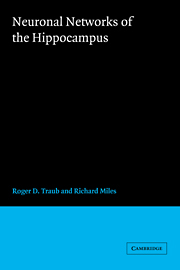Book contents
- Frontmatter
- Contents
- Acknowledgments
- Prologue
- 1 The hippocampus in context
- 2 Physiology of single neurons: voltage- and ligand-gated ionic channels
- 3 Synaptic function and organization of the CA3 region
- 4 The single-cell model
- 5 Model of the CA3 network
- 6 Collective behaviors of the CA3 network: experiment and model
- 7 Collective behaviors of the CA3 network: spontaneous oscillations and synchronized synaptic potentials
- 8 Field effects
- 9 Theoretical approaches: mathematical neural networks
- Conclusion
- Notes
- References
- Index
3 - Synaptic function and organization of the CA3 region
Published online by Cambridge University Press: 05 February 2012
- Frontmatter
- Contents
- Acknowledgments
- Prologue
- 1 The hippocampus in context
- 2 Physiology of single neurons: voltage- and ligand-gated ionic channels
- 3 Synaptic function and organization of the CA3 region
- 4 The single-cell model
- 5 Model of the CA3 network
- 6 Collective behaviors of the CA3 network: experiment and model
- 7 Collective behaviors of the CA3 network: spontaneous oscillations and synchronized synaptic potentials
- 8 Field effects
- 9 Theoretical approaches: mathematical neural networks
- Conclusion
- Notes
- References
- Index
Summary
In this chapter we review data on unitary synaptic interactions between hippocampal neurons necessary to construct a model of the CA3 neuronal network. First, the properties of excitatory and inhibitory synapses between hippocampal neurons are described. We then show that the properties of single synapses allow certain details of the operation of simple recurrent circuits to be deduced. Finally, we consider how activity occurring in multiple parallel circuits is integrated into the summed activity of a large neuronal network. These matters will be further expanded in later chapters.
Our current knowledge of synaptic function has been derived from only a few synapses, such as neuromuscular junctions in frog (Katz, 1969) and crayfish (Atwood and Wojtowicz, 1986), the giant synapse of the squid stellate ganglion (Llinás and Nicholson, 1975), synapses on goldfish Mauthner cells (Korn and Faber, 1987), and Ia afferents terminating on spinal motoneurons (Rail, 1967; Redman and Walmsley, 1983). Are these synapses useful models for understanding connections between cortical cells? Clearly, cortical synapses must be studied directly to provide appropriate information. Such studies have proliferated with the increasing use of isolated preparations. From these studies, values are emerging for several critical parameters of cortical synaptic function. We shall give current estimates from connections between hippocampal neurons.
First, what is the amplitude of postsynaptic potentials evoked by a single presynaptic excitatory or inhibitory neuron?
- Type
- Chapter
- Information
- Neuronal Networks of the Hippocampus , pp. 46 - 73Publisher: Cambridge University PressPrint publication year: 1991
- 2
- Cited by



